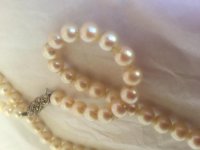I'm sorry, they are still out of focus. Does your camera have a close-up setting? Most do. You'll have to hold the camera very still.
They could be cultured akoyas or they could be imitation (their roundness is because there is a bead inside, whether they are akoyas or imitations.) The grittiness would normally lean me toward akoyas, but grime could also make them feel a bit gritty.
It will be easier to know what they are if they are clean. Give them a bath in some warm, mild-soapy water, letting them soak for 10 minutes or so, then wipe the pearls clean with a soft cloth. Cotton swabs can be used to clean between the pearls where the grime has accumulated most. Then rinse and wrap them in a soft clean towel to dry.
Then try photographing again. Or just do some other tests:
• Rub one pearl gently against another. If you still feel resistance when rubbing, they are likely akoyas.
• Examine the area around the drill holes. If imitation, there may be swirls of excess coating, although the best imitations (like Majorica) won't have that. Sometimes imitation pearl coating peels away near the drill hole or elsewhere, revealing the glass bead inside (it's usually glass, although very cheap lightweight imitations may have plastic beads, and some imitations have shell beads.) Genuine akoya pearls may also have peeling nacre near the drill holes (and then you can see the shell bead underneath), but the nacre of a real akoya pearl will look thicker than the coating of a fake pearl, where it peels.
• Look at the strand as a whole. Is there any variation in the overtone colors of the pearls? You won't see this with imitations, but you may also not see this with lower-luster akoyas.





